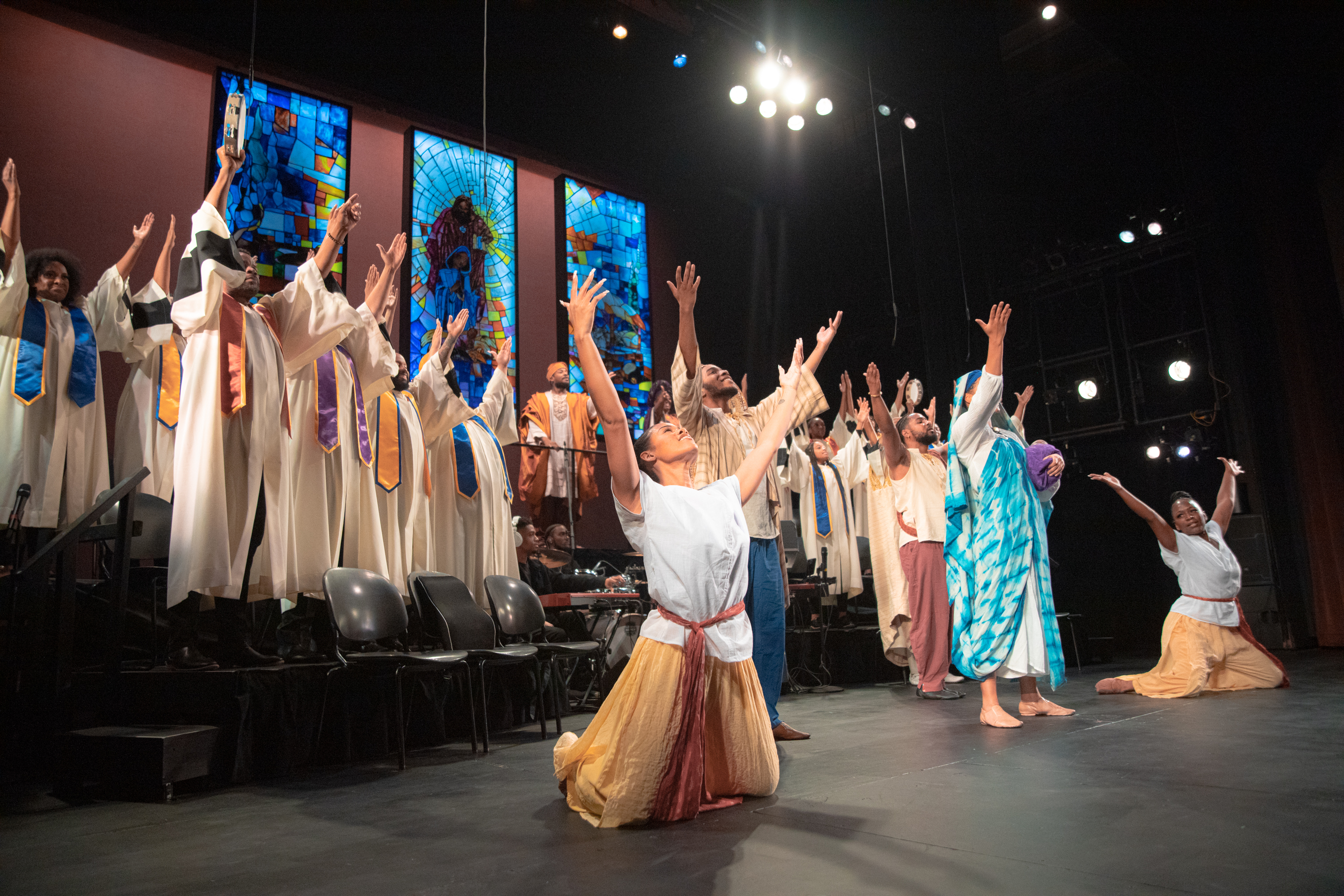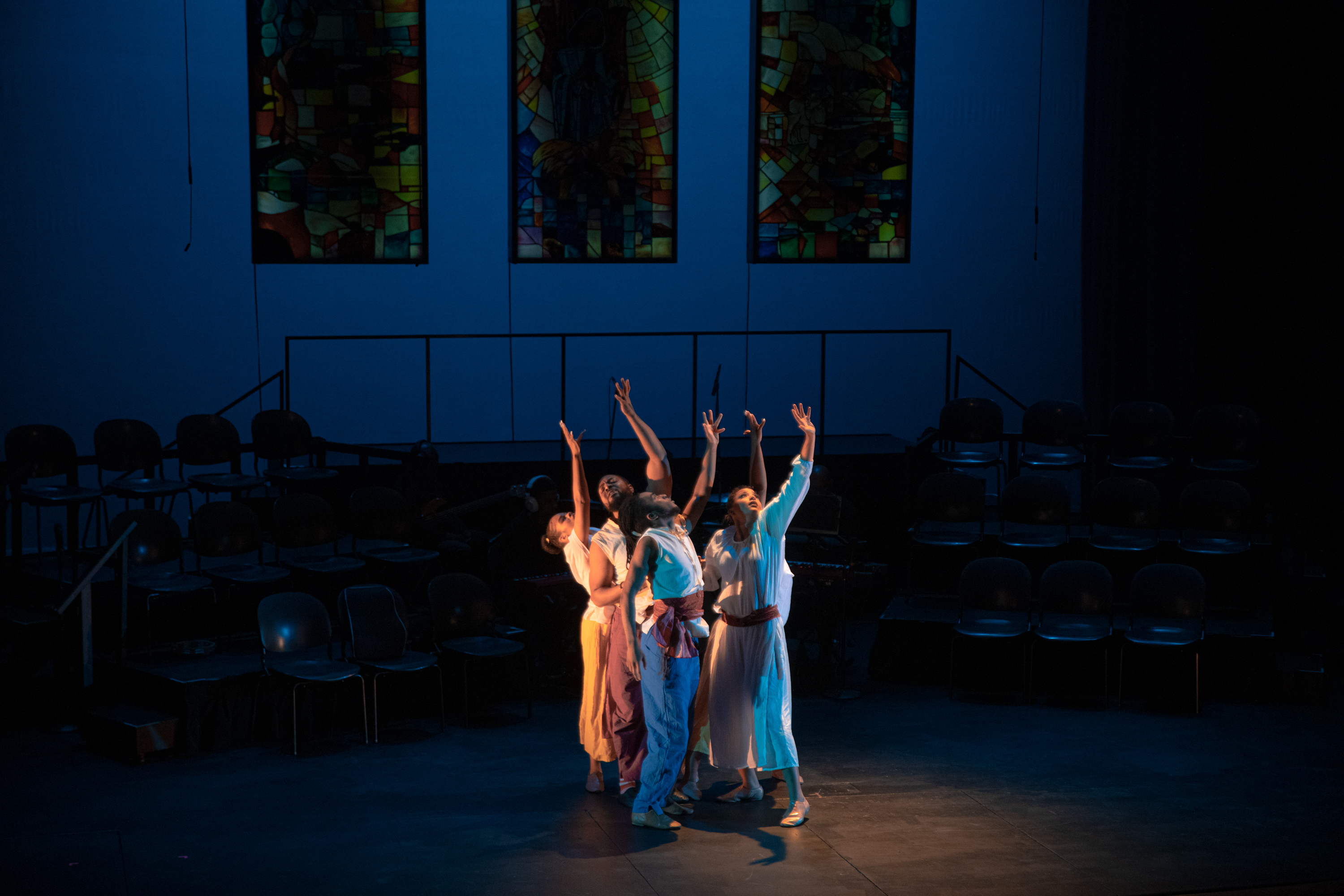We Can Do Together
Review of Black Nativity at Intiman Theatre
Written by TeenTix Newsroom Writer Karli Kooi and edited by Teen Editorial Staff Member Kyle Grestel

At the end of each year from 1998 to 2012, a staging of Black Nativity by playwright Langston Hughes was produced by Intiman Theatre, captivating Seattle audiences with a poetic celebration of Black joy and talent. Despite Black Nativity’s 10-year hiatus, fans inquired about tickets to the show each winter. This past December, director Valerie Curtis-Newton answered prayers for a Seattle revival with a reimagined production, adding a new act that embraces Black Gospel culture to bring warmth, exultation, and connection to Seattle audiences. The 2023 production also features choreography by Vania C. Bynam and music direction by Sam L. Townsend Jr. It is presented in partnership with The Hansberry Project, a professional African American theater lab “dedicated to the artistic exploration of African American life, history, and culture” led by Curtis-Newton. Founded in 2004, The Hansberry Project aims to provide the community with “consistent access to African American artistic voice… rooted in the convictions that black artists should be at the center of the artistic process, that the community deserves excellence in its art, and that theatre’s fundamental function is to put people in relationship to one another.” Their motto, “Where ART meets SOUL!”, is magnificently reflected in Black Nativity.
The show was first produced off-Broadway in 1961 with a cast of over 160. Since 1970, it has been performed yearly as a cherished tradition in Boston and continues to move and delight audiences nationwide. The show includes an all-Black cast and features design elements that incorporate African and African-American culture. The play, written as one act, is divided into two acts in this reignited production. The first part follows the Christian nativity story of Mary giving birth to Baby Jesus. Black Nativity adapts the classic tale with humor and regard. An incredibly talented gospel choir accompanies soloists from the group as well as a featured cast of five. The choir is clad in classic choral robes, sits around a lively band. Both choreography and choir-ography by Bynam accompany the production. The dancers move in individual spirit; their movements aren’t synchronized, but they’re aligned in their verve and emotion. Solos and duets enhance both sung and spoken passages, and technical vocal talent connects strong feelings with expressive dancing. The costumes by Dannielle Nieves, worn by dancers, featured characters, the five-person cast, and the onstage music director, provide vibrant texture and color to the show. Highlights include a pleated gold cape on an angel, beaded and frilled headpieces, and a blue, tie-dyed wrapped dress around the dancer Mary. Radiant lighting, by designer Robert Aguillar and assistant designer Chih-Hung Shao, masterfully shifts in tones with the story’s spirit. The set, designed by Jennifer Zeyl, consists of stained glass windows hanging above the stage. An upper platform allows for engaging cast movement that enhances this first act.

After the production pauses for an intermission, the cast and crew appear to be preparing to leave. With this, the audience chooses hymns to sing with the cast, transforming the show from a play performance into a collective celebration. Now in street clothes, Townsend Jr. rouses everyone’s spirits and delivers messages of collective strength, such as how what we can’t do alone, “we can do together.” Townsend playfully interacts with the audience, asking for preferred songs and directing us in collective singing, with provided lyrical sheets. Don’t know the melody? No problem—the varied audience includes people with all levels of lyrical knowledge and singing enthusiasm, creating a soaring collective joy. No dancing accompanied this act, but both the cast and audience stood and celebrated with impressive vocalizations. The band expertly accompanies the entire show with dynamic pianists, plucky bass, and hot, hot drums. When an audience member began singing solo, as prompted by Townsend Jr., the musicians’ ear training shined as they picked out the correct musical key and began providing accompaniment.
As the show concluded, a joyous audience, albeit sweaty from the densely packed theater, bemoaned the end. The only change I suggest? Print and distribute the choral lyrics on church fans. As we spilled into the lobby newly connected, laughter and even continued singing filled the air. Stepping into the cool Seattle night, I felt lifted and restored by the uniquely powerful show. When Black Nativity ideally returns this coming December, I know I will be in attendance, and you should be too.

Lead Photo Credits: Dancer Kearia Keke Duncan in Black Nativity, Photo by Joe Moore
The TeenTix Newsroom is a group of teen writers led by the Teen Editorial Staff. For each review, Newsroom writers work individually with a teen editor to polish their writing for publication. The Teen Editorial Staff is made up of 5 teens who curate the review portion of the TeenTix blog. More information about the Teen Editorial Staff can be found HERE.
The TeenTix Press Corps promotes critical thinking, communication, and information literacy through criticism and journalism practice for teens. For more information about the Press Corps program see HERE.

